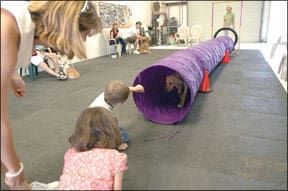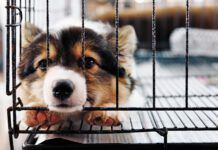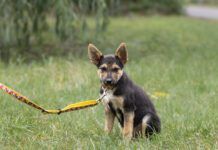[Updated December 26, 2018]
There was once a time when you rarely encountered the word “socialization” in dog circles. Today it’s the new training buzzword; if you haven’t heard it at least three dozen times by the time your dog is a dozen weeks old, you and your puppy must be living in a cave.
A half-century ago, no one talked about canine socialization because they didn’t need to. For the most part dogs wandered freely in their neighborhoods, accompanied kids to the school bus stop, hung out with canine pals all day, and became naturally socialized to their world and the people, dogs, and things they encountered in their daily travels. Sure, they got into occasional scuffles amongst themselves, but they sorted it out. Yes, a kid was bitten every now and then, but it was no big deal. Dogs got hit by cars from time to time, but that was part of life – sad, but one could always find another dog, preferably one who would be smart enough to stay out of the road.

Today a large segment of our pet-owning population is made up of more responsible canine guardians and caretakers. A nationwide paradigm shift has changed our attitudes about our dogs. No longer just “pets,” many of our beloved four-legged family members are kept inside our homes and in safely fenced yards, supervised closely when around children, and only encounter other dogs under controlled conditions – at training class, maybe during a brief on-leash greeting, during scheduled play dates, and perhaps at the dog park. The thought of our beloved dogs running free in the streets gives us heart palpitations, and we grieve terribly whenever we lose one.
On the plus side, this means our dogs live longer, physically healthier lives. On the minus side, it means they no longer benefit from the natural socialization process that occurred when they were allowed to explore their world and figure out how things work on their own. As a result, we’ve spawned a whole new behavior problem: undersocialization.
Raising a Social Dog
Socialization is really classical conditioning – creating an association between two stimuli. Behavioral scientists have identified the period from 4 to 14 weeks as the most important window of time for a puppy’s social development. After the age of 14 weeks that window starts to close, and it closes pretty quickly. If a pup is super-socialized during this important developmental period he’ll most likely believe the world is a safe and happy place. If he’s not well-socialized, he’s likely to be neophobic, which means fearful of new things. This is a common condition in dogs rescued from puppy mills and hoarder situations. It is challenging to own and train a dog who is afraid of everything new he encounters; worse, the neophobic canine is also a strong candidate for developing fear-related aggression. (For more about fearful dogs, see “Reducing Your Dog’s Anxieties,” WDJ April 2007.)
Lack of exposure to new things is one cause of undersocialization; inappropriate exposure is another. If you’re not careful during your socialization efforts you may inadvertently set your pup up to create negative associations with parts of the world around him. In that case you can actually sensitize your pup to the things you’re introducing him to – that is, you can make him afraid of them – the exact opposite outcome of the one you want.
Think of the well-meaning soccer mom who takes the family’s brand-new nine-week old pup to watch her son’s team practice. The entire team suddenly spies the adorable fluffball and charges toward the pup to oogle over him. The terrified puppy screams, pees, and tries to run away when he sees a dozen giant human creatures coming toward him at a dead run. He can’t escape; he’s trapped by the leash, which panics him even more.
Mom sees the pup flailing at the end of the leash and scoops him up in her arms to calm him so the boys can pet him. Now he’s even more trapped! One boy reaches to pat him on the head, and the pup, thinking he may be about to die, as a last resort snaps at the lowering hand that appears poised to grab him. The boy yanks his hand away, and mom smacks the puppy for being “bad.”
How much worse could it get? This puppy now has an extreme fear of children, especially boys, thanks to at least three negative classical associations in rapid succession:
1. Boys/children are scary; they run toward you in large packs.
2. Boys/children are scary; they try to grab your head.
3. Boys/children make bad things happen – when they are nearby, mom becomes violent.
The pup may also have developed negative associations with the collar and leash, wide open fields, being picked up, and mom. In addition, he learned one important operant lesson – snapping is a successful behavioral strategy for making scary hands go away. None of these things are the lessons we want a young pup to learn! And now the puppy is labeled as “not good with children” and a “fear-biter.”

We often talk about how long it can take dogs to generalize operantly conditioned behaviors (if I do “x” I can make “y” happen). In contrast, dogs tend to form classically conditioned associations, especially those that produce strong emotions, very quickly.
The good news is that at nine weeks this pup’s socialization window is still wide open, and if his owner is smart she has time to repair the damage. Unfortunately, most owners don’t realize the importance of taking immediate steps to change a pup’s association if he has a bad experience at a young age.
Socialization is the process of giving a puppy positive associations with the people, places, and things in his world. You need to be sure he’s having a great time, playing fun games, getting good stuff, and protected from scary stuff while you’re teaching him that the world is a safe and happy place.
Socializing Puppies in Their Earliest Days
If you bring your new pup home when he’s 8 weeks old, 4 of his 10 prime socialization weeks are already gone. Since a quarter to a half or more of a pup’s most important socialization time has passed by the time he leaves his mother and moves into his forever home, it’s vitally important that breeders invest time and energy into socializing their litters.
This includes having the pups walk and play on different substrates (grass, gravel, concrete, carpeting, and vinyl); inviting lots of different kinds of people over to play with and handle the pups; exposing them to household objects and sounds (microwave, telephone, television, vacuum cleaner); and making sure the baby dogs have positive associations with all these things.
Sadly, a small minority of breeders do a really good job of it, which contributes significantly to the population of under-socialized dogs in our world. If the breeder of your pup did her part, then your pup is already well-started on his super-socialization program. Now it’s your responsibility to keep it up.
If your pup comes to you from a socially impoverished environment, you’ll already see the signs of neophobia. You have no time to lose, and you may never be able to make up all the ground he’s lost, but you can make him better than he’d be otherwise. Trainers talk about giving pups “100 new (positive) exposures in the first 100 days.” If your pup is already showing signs of timidity or fear, triple that to 300 exposures in 100 days. And get busy!
Puppy Kindergarten Classes
A well-run puppy class is one of the best places to find lots of positive socialization opportunities. Unfortunately, because of their fear of disease transmission, some veterinarians still caution their clients with puppies to keep their young canines safely at home until fully vaccinated, or at the very least until they have received a minimum of two shots, usually by the age of 12 weeks. Twelve weeks leaves only two weeks of critical socialization time – assuming there’s a class starting up immediately after the pup receives his second shot. Not good enough!
We asked longtime positive trainer Gail Fisher of All Dogs Gym & Inn, located in Manchester, New Hampshire, to share her experiences with and thoughts on puppy classes. Here’s her response:
“Regarding the question of puppy socialization versus risk of illness: We have been running puppy classes and play sessions for puppies as young as eight weeks since 1976 (which, incidentally, was before parvo!) In all this time, we have had a total of three puppies in our classes who were diagnosed with parvo (or anything worse than canine cough – a mild upper respiratory infection similar to the common cold).
“The first was a five-month-old Rottweiler (a breed known for having immunological issues – and beyond the age of a typical ‘puppy’ class). The second was a puppy from a breeder that had been in its new home for two weeks and who had received two shots, and the third was a pet shop puppy who had been purchased two days before starting class.
“More importantly, however, is the fact that no other puppies in any of those classes got sick. As soon as we heard from the owners of the sick puppies, we immediately contacted every other puppy owner to tell them to check with their veterinarian for advice on whether to have an additional inoculation. Some did, some didn’t – but no one else got sick.
“So if you’re looking for ‘odds’ – in 33 years, figure (conservatively) 100 puppies a year, more than 3,000 puppies – the odds of a puppy getting sick from a well-run training class is virtually nil (less than 1/100th percent). The risks of illness are, in my opinion, negligible, while on the other hand, the advantages to socialization are unmeasurable.
“I hope this helps in your decision to take your puppy to training class!”
Places NOT to Take Your Puppy
As important as socialization is, it’s equally important to avoid places where there’s a high risk of endangering your baby dog’s health or safety, or giving him a negative association with his world. Here are just a few examples of places you shouldn’t try to socialize your pup:
– Off-leash dog parks, until he is fully vaccinated.
– Any place where he is likely to encounter stray dogs.
– Any place where he is likely to encounter sick dogs.
– Any place where he is likely to encounter aggressive dogs.
– Any place where he is likely to encounter aggressive/rowdy/drunk humans.
– Places where there is an accumulation of feces from unknown dogs.
– Any place he is not welcome.
– Any place where he would have to be left unattended, or in a hot car. (No tying up outside the grocery store!)
– Any place where he will be uncomfortable or frightened (sitting in the full sun while you watch your son’s Little League game, at a July 4th fireworks display, at a motorcycle rally, etc).
– Any place where you won’t be able to devote enough attention to him to ensure his safety, security and well-being.
Genetics and Social Confidence in Dogs
Of course, your dog’s genetics also influence his behavior and social tendencies. Behavior is always a combination of genetics and environment. Nature and nurture. Always.
Genes dictate how easily reinforced a dog is for the things the environment tosses at him during his lifetime. Hence a dog who is genetically programmed to be reinforced by chasing things that move becomes a good herding dog, fox hound, or ratter. The difference is the herding dog is (hopefully) not programmed to be reinforced by killing the things he chases, while the hound and the terrier are.
Pups who are genetically programmed to be reinforced for the consequences of acting behaviorally bold are naturally easier to socialize, even if their first few weeks lacked stimulation, than ones who are genetically programmed to be reinforced for the results of acting timid or fearful. How do you know which behavioral genes your pup has for social behavior? You really don’t.
It’s useful to see your pup’s parents – at least the mother, if at all possible. If Mom is timid or aggressive there’s a good chance her pups will be, too. The pups’ behavior still can’t be attributed solely to genes; pups can learn fearful or aggressive behavior by watching their mother’s response to humans and other environmental stimuli, a behavioral phenomenon known as social facilitation. If you’ve been paying attention you’ll remember that genes and environment both play a role in behavior – always.
Don’t despair if you adopted your pup from a shelter or rescue group. It’s true that if you never see Mom or Dad, you won’t get any hints about their behavior. So how do you know how much socialization your pup needs to overcome any genetic weakness in temperament? You don’t. But you don’t need to. The answer to the genetic mystery is to super-socialize every single puppy, regardless of what you think you know, or don’t know, about his genetics. If you do that, you’re guaranteed to help your pup be everything he can be, socially speaking.
There’s no such thing as overkill when it comes to properly done socialization. You can’t do too much. Pups who are super-socialized tend to assume that new things they meet later in life are safe and good until proven otherwise. Dogs who are very well-socialized as pups are least likely to develop aggressive behaviors in their lifetimes. Pups who aren’t well-socialized tend to be suspicious and fearful of new things they meet throughout their lives, and are most likely to eventually bite someone. You’d better get out there and get started!
Creating 100 Positive Exposures in 100 Days
by Nancy Kerns
Whole Dog Journal‘s Training Editor Pat Miller has long advocated the concept of engineering 100 positive, novel experiences for a puppy in his first 100 days with his owner. The idea is to consciously, deliberately expose him to all sorts of sights, sounds, smells, and other beings in such a way that he comes away from each experience thinking, “That was cool!”
But given the uncontrollable nature of the real world, it’s no small task to devise these encounters so that they always have a positive outcome. Fire trucks may suddenly appear
with sirens wailing. A passing dog may suddenly explode into a fit of barking and barely controlled aggression. And people are unpredictable! You never know when someone will take it upon themselves to do something stupid or scary to your dog, like grab his cheeks and pull him close for what is meant to be an affectionate kiss (but which terrifies your shy puppy).
While it’s clearly impossible to control every aspect of your outings, a certain amount of planning will prevent many overwhelming experiences. Avoid taking your sound-sensitive
youngster to neighborhoods that are home to a fire station or hospital. If you see, coming toward you and your pup down the sidewalk, a dog straining at the end of his leash, or appearing to be overly alert, eyes fixed on your puppy, do a snappy about-face. Jog away with your pup with a cheerful, “Yay! Let’s go!” and cross the street as soon as you can.
Most important, though, is to communicate proactively with the people that you allow to approach or pet your dog. You can usually tell when a person might be interested in meeting your dog, and when they don’t care for dogs. If a person makes eye contact with me in a friendly fashion, or is looking at my dog and smiling, I always say, “Hello, how are you?” If it appears that she would like to pet or greet my dog, I try to subtly prevent her from actually touching my dog (by slowing my pace, or stepping slightly between my dog and the person) until I can say, “He’s a little shy; would you mind giving him a treat?” and I hand her a treat. Given that information, most people will move slowly and greet the dog gently.
(Note: Miller recommends that owners not allow strangers to feed treats to a shy dog until the owner has done a ton of counter-conditioning to the sight of strangers. That way, the dog already has a positive emotional response to strangers, and will accept treats from a stranger safely, with minimal stress.)
No matter how well or poorly they follow instructions, though, I always praise my dog and give him a treat or pet him right after the encounter. When I got him at the age of seven
months, he was shy with strangers; now his tail starts wagging in anticipation whenever he sees someone coming toward us. The sight of a stranger has become a predictable indicator that praise and a treat are on the way.
Start Close to Home and Branch Out
You’ll find many opportunities in your own neighborhood for 100 new, positive exposures, including the mail delivery person, FedEx driver, kids on bikes, a skateboarding teenager, a passing bus, and an elderly neighbor. Go out of your way to approach people who appear unique (to your pup) in some way: their size (extra large, extra small); skin color; mode of transportation (wheelchair, crutches, skateboard, bicycle); and manner of dress (trench coat, hat, beard, backpack, skirt, shorts, pants).
You’ll also want to get into the habit of taking your pup with you to as many other safe places as possible, where he’ll have more opportunities to enhance his socialization. In a
local park, for example, he might have further opportunities to encounter baby strollers, kites, flying Frisbees, and people enjoying picnics. A cafe with tables on the sidewalk might offer a great place for your dog to meet a high volume of people with disparate appearances.
As your pup gains experience and confidence, you can start taking him with you when you run errands at businesses that allow dogs (hardware store, pet supply store, copy shop) or offer walk-up service (bank ATM, post office, or ice cream stand).
Miller suggests that dog owners keep an actual written list of their pup’s socialization exposures, to help ensure that they attain (and, we hope, exceed) the goal of a minimum of one new exposure per day in the first 100 days they spend together. Whole Dog Journal developed a list, too, which you can use to get started. If you put a little effort into it, we’re betting that you’ll get there well before 100 days are up – more likely in half that time!
CREATE A CONFIDENT DOG: OVERVIEW
1. Make a commitment to super-socialize your puppy, and then do it – early. Don’t procrastinate; you don’t have much time!
2. Stay aware of your pup’s body language and help him out of trouble if he looks stressed.
3. Be prepared to take prompt remedial action if your pup has a negative experience during your socialization program.
4. Sign up ASAP for a well-run positive puppy class, where both of you can socialize and have a good time.
Pat Miller, CBCC-KA, CPDT-KA, is WDJ’s Training Editor. She is author of The Power of Positive Dog Training; Positive Perspectives: Love Your Dog, Train Your Dog; Positive Perspectives II: Know Your Dog, Train Your Dog; and Play with Your Dog.
Gail Fisher is the owner of All Dogs Gym & Inn in Manchester, New Hampshire.







A foster home for animals do take care the animals and safe them.